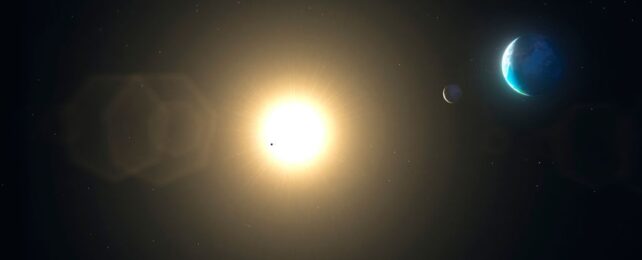The star at the center of our Solar System – the Sun – may be infinitesimally smaller than scientists thought.
A team of two astronomers has now found evidence that the radius of our Sun is a few hundredths of a percent slimmer than previous analyses indicated.
That might not sound like much, but it could make a considerable difference in how scientists understand the glowing ball of light that keeps our planet humming with life.
The new results, which are currently undergoing peer review, are based on sound waves generated and trapped inside the hot plasma of the Sun's interior, called 'pressure' or p-modes. Like a growling belly, these resonating noises can hint at pressure changes going on inside the solar gut.
According to astrophysicists Masao Takata from the University of Tokyo and Douglas Gough from Cambridge University, p-mode oscillations allow for a "dynamically more robust" view of the Sun's interior compared to other oscillating sound waves.
To understand what this means, it's easiest to imagine the Sun as a ringing bell, although not a bell that has been struck once – one that scientists at Stanford University describe as constantly being whacked "by many tiny sand grains".
All that seismic commotion produces millions of oscillating sound waves or 'modes', which scientists can remotely measure.
As well as the push-and-pull of p-waves there are ripples that bob up-and-down under the force of gravity, called g-modes, which are referred to as f-modes when they occur closer to a star's surface.
As stars become more dense, other modes can arise that can be used to describe the object's characteristics.
F-modes are particularly useful for studying the swirling hot plasma in the Sun's interior, whereas p-modes are most useful for gleaning the 'spherical harmonics' of the Sun.
That's because p-modes are produced via pressure fluctuations in the Sun's interior. As these waves move outward, they hit the surface of the Sun (its photosphere) and reflect inward again, bending as they travel through turbulent plasma to ricochet off another part of the Sun's surface.
Combining a massive number of these modes can build up a picture of the Sun's structure and behavior.
But which to choose?
The traditional reference model for the Sun's seismic radius is based on f-modes, as these were measured first.
But f-modes, some astronomers argue, are not wholly reliable, because they do not extend right to the edge of the Sun's photosphere. Instead, they seem to 'ding off' what Takata and Gough call a "phantom surface".
P-modes, according to some past research, reach further, because they are less susceptible to magnetic fields and turbulence in the upper boundary layer of the Sun's convection zone.
When basing the Sun's radius on seismic measurements (and not on visible light or thermal calculations), Takata and Gough argue that p-modes are the way to go.
Their calculations using only p-mode frequencies suggest the solar photospheric radius is very, very slightly smaller than the standard solar model.
Never mind how small the error, astrophysicist Emily Brunsden told Alex Wilkins at New Scientist that changing the more traditional model to suit such findings would be no small matter.
"To understand the reason for their difference is tricky," Brunsden said, "because there's just a lot of things going on."
The preprint paper was published on arXiv.
